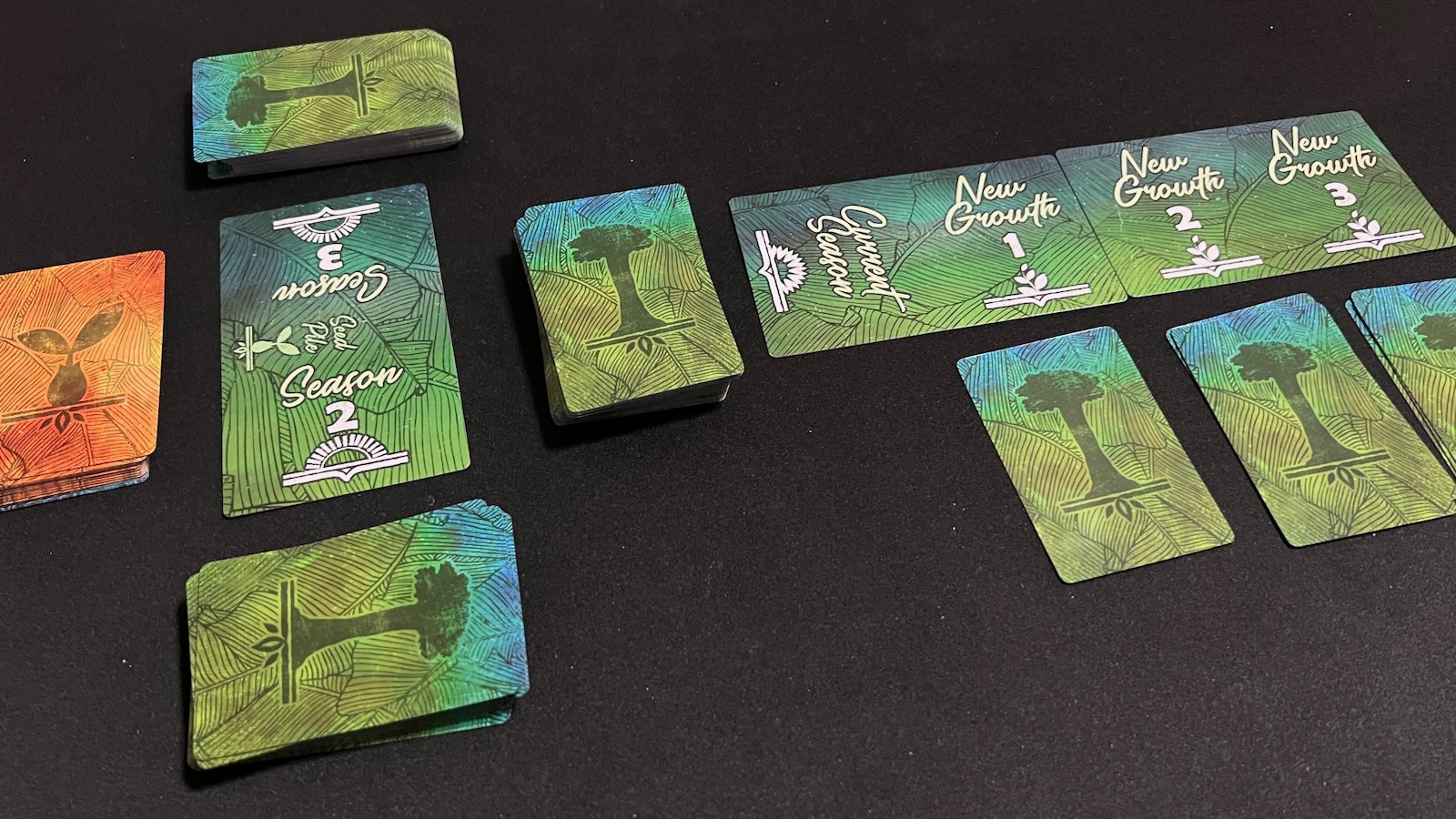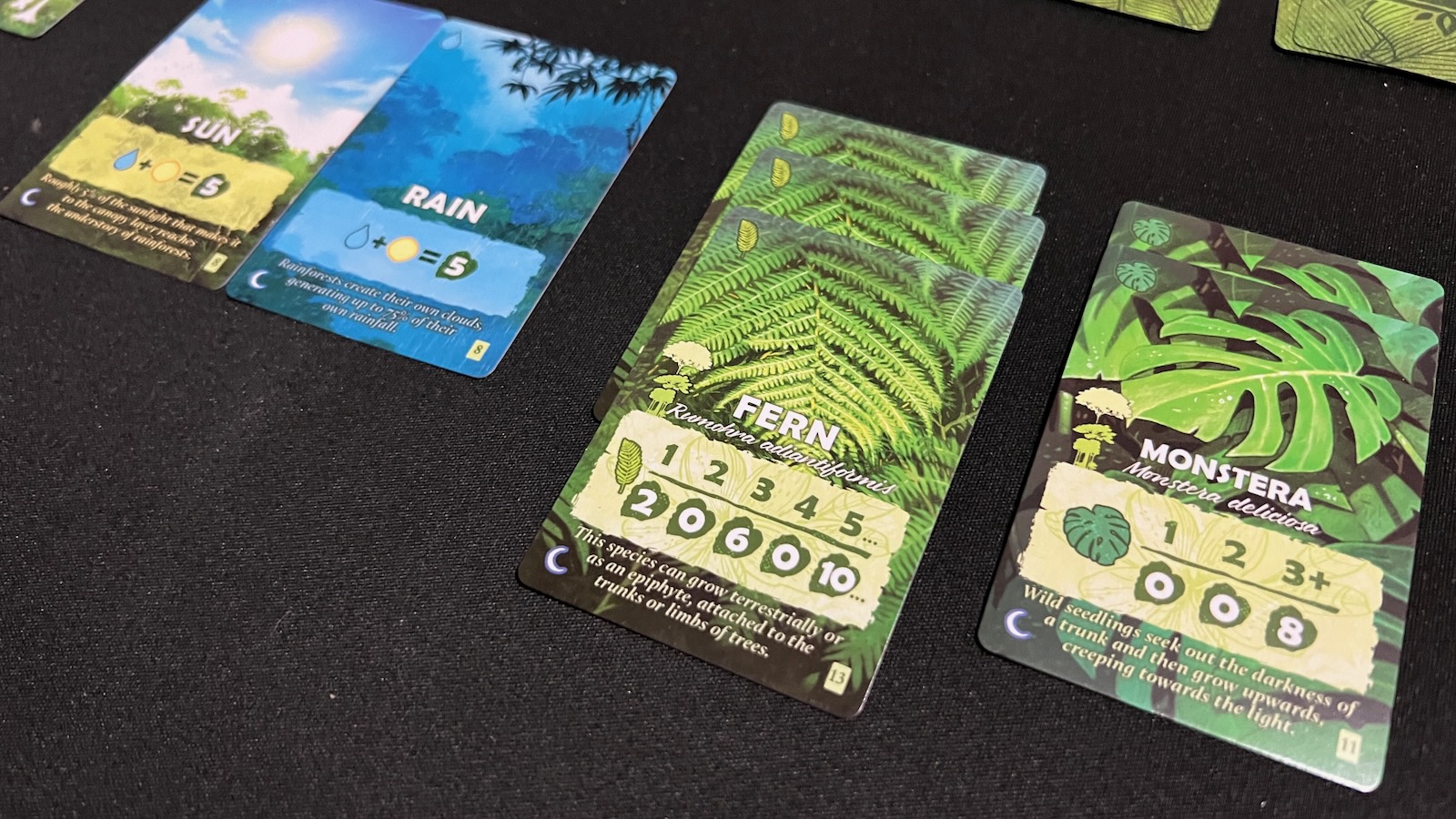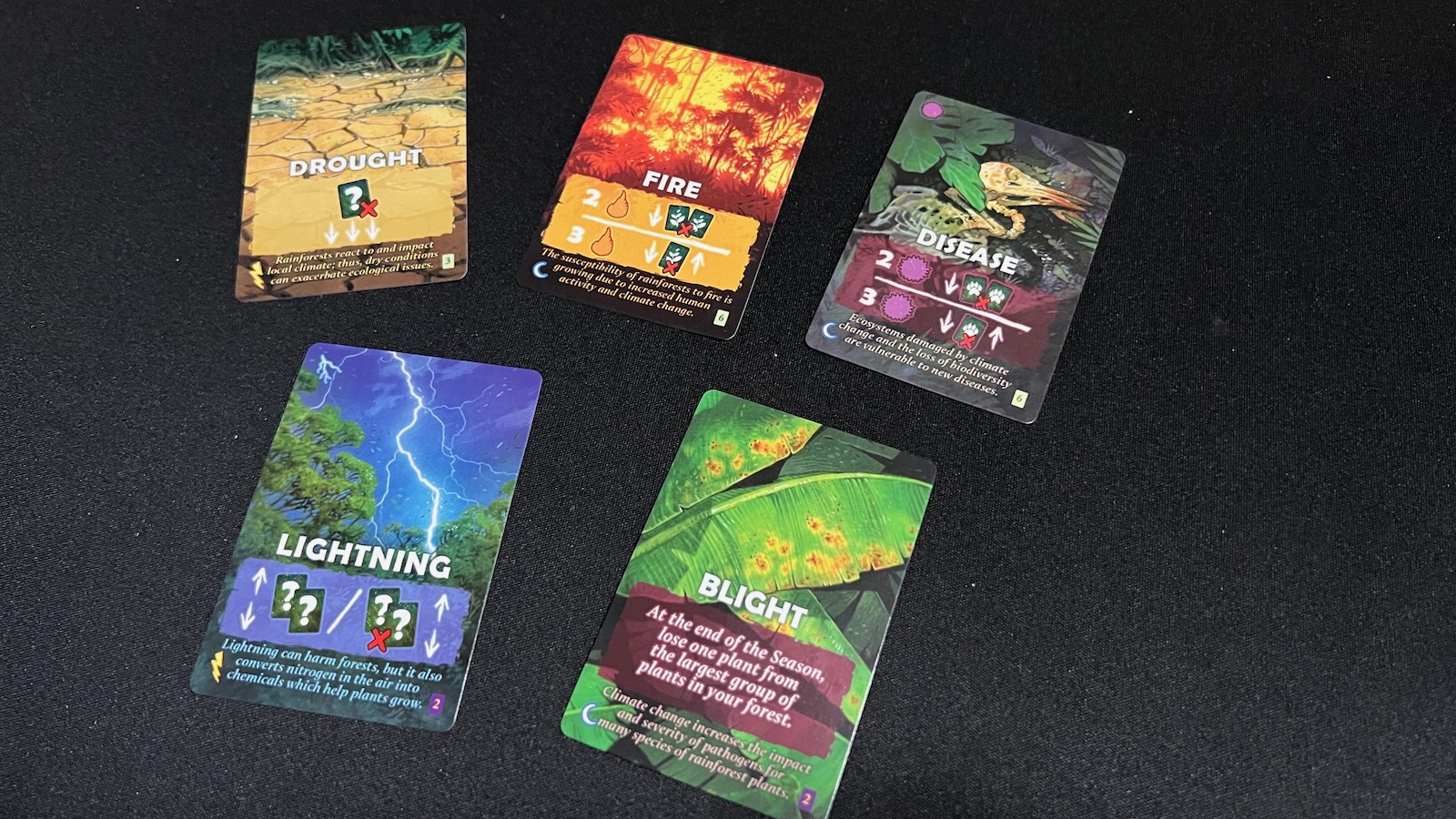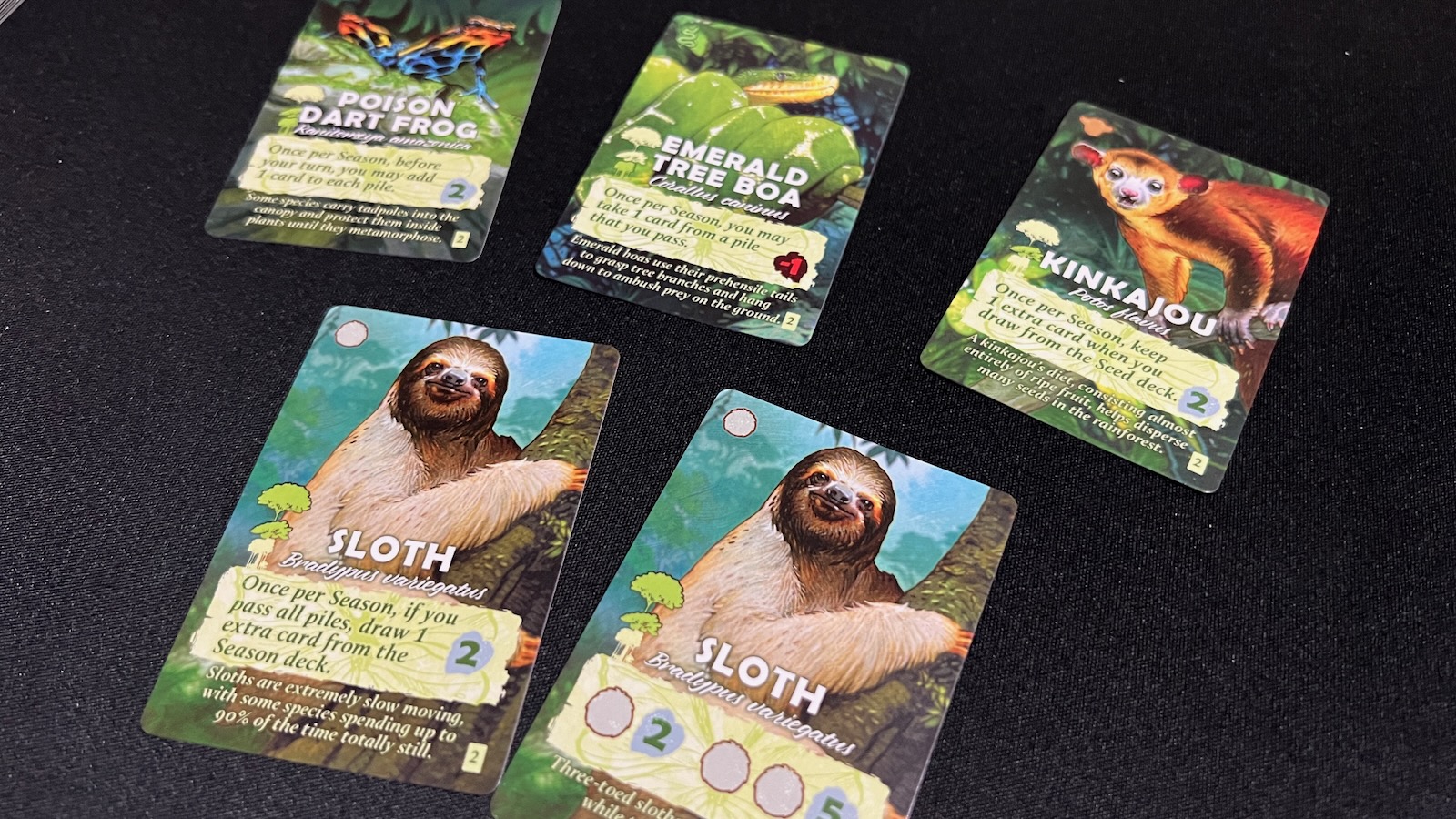
I play a lot of two player games these days. My wife and I are always looking for a good mid-week game that we can get to the table and play together. We both work in education so after a long day at work, our brains can be fried, and the last thing we’re putting on the table is a 2-3 hour brain burning euro. Enter Canopy, a beautifully illustrated 2-player card game that is perfect for that mid-week pick me up gaming session.

Canopy, released in 2020 by Weird City Games, was designed by Tim Eisner and illustrated by Vincent Dutrait. Canopy was made to be a two player game but comes with solo and 3-4 player variants. Throughout the game, players will alternate turns where they will draft a pile of cards containing plants, animals, seeds, calamities, and elements of trees. These cards will be added to their forest tableau to score points. After three rounds, the player with the most points wins!
Overview

To set up the game, players will each take a starter trunk to add to their forest. Players will then shuffle the rainforest deck and divide them into three equal piles, placing them next to the round markers. Players will do the same with the seed deck and place it next to the seed pile. From the first deck of rainforest cards, players will place one, two, and three cards face down in front of the three “new growth” spots on the center cards. The gameplay of Canopy is pretty straight forward.
Players will alternate taking turns. The active player takes all the cards in New Growth 1 and decides whether to add the pile to their forest. If they take the pile, a new card from the deck is placed to start a new stack. If they pass, a card is added to the pile and the player will move on to stack 2, following the same process. If a player passes on all three piles, they will take a random card from the top of the active season deck.

All cards from the chosen pile, or the randomly drawn card, are added to a player’s forest. The deck consists of the following cards:
- Plant Cards will earn points by collecting different sets. Each species of plant will have different quantities needed to earn, or sometimes lose, points.
- Wildlife Cards come in pairs. One of the wildlife cards of a given species will have a special ability to earn points or take a special action in the round. The animal’s pair will give end of round points for having one or both animals in the pair.
- Root/Trunk Cards either start new trees or can be added to existing trees in your forest. These cards all have a value of 0, 1, or 2.
- Canopy Cards have to be placed on the tops of growing trees, if drawn. The canopy cards add a scoring bonus to the trees and are scored at the end of the round.
- Weather Cards are labeled as either rain or sun. Each pairing of sun and rain will score 5 points at the end of the round.
- Seed Cards allow players to draw from the seed deck at the end of the round. By having at least one seed card, players will draw three cards from the seed deck and keep a number of these cards matching the amount of seeds in the forest. These seeds are more copies of the plant and tree cards, potentially leading to more points for the round.
- Threat Cards, on their own, are almost all harmless, but adding more to the forest brings a penalty. Two of a single type will take out two cards from your forest, and three cards spread to your opponent and both players will discard cards. Fire cards kill plants, but can also allow players to draw more seed cards at the end of a round. Disease cards kill wildlife. Drought cards will immediately cause players to discard a card when gained, but can be beneficial when trying to get rid of other threat cards.

Play will continue until all cards from the current season are claimed by players. If the season deck is empty, players will have to take the last available pile of cards on their turn instead of passing. At the end of a round, or season, players will go through the following order:
- Seeds: Draw and claim cards from the seed deck.
- Fire and Disease: Evaluate the effects of having two or more disease and/or fire cards.
- Trees: Score the visible points on completed trees as well as the scoring condition found on the canopy. Players will use an animal token to mark scored trees. The player with the tallest completed tree, from any round, will win a bonus point token. At the end of the game, the player with the most completed trees will gain 10 bonus points.
- Plants & Weather: Score sets of plants and weather cards.
- Clean Up: All cards from players’ forests are discarded except for tree cards. Players will then grab the next season deck and set up the new growth piles for the next round.
At the end of three rounds, the player with the most points wins the game!
Variants

Canopy comes with a few variants, once players have learned the base game.
The Shifting Seasons variant adds another deck of cards. At the beginning of each round, a card is flipped adding a new rule to the game that applies for the round. These could be rules that affect the drafting of card piles or even adding a fourth new growth pile to the game.
Another variant takes out the wildlife cards from the base deck and replaces them with different wildlife cards in addition to a new lighting threat and new plants. Lightning allows the active player to make both players draw a card from the season deck or discard a pile from their forest.
While the game is primarily designed for two players, the game also comes with three and four player rules, as well as a solo ruleset. In the solo game, the player will play against the Forest Spirit. The Forest Spirit plays similarly to another player, but has special rules on which piles to pick and has some scoring bonuses, such as having more threat cards in the forest during end of season scoring. In the three or four player games, new growth piles are shared with the partners to your left and right with only new growth three being communal with all players. There are also some changes to how some cards work throughout the game and only two rounds are played.
Production

The first thing to note is the beauty of the game. The color palette is inviting with cool blues, greens, and orangish browns for the backs of cards and vibrant foliage and wildlife illustrations on the fronts. The iconography of the cards is easy to follow without sacrificing beautiful images that could have distracted from the gameplay. The cards are high quality and even though shuffling over a hundred cards can be annoying, they still hold up after numerous games. The only strange addition to the box came in two paper envelopes that could be used to hold some of the cardboard components instead of a plastic bag, but are not as functional.
Gameplay

This game is definitely easy to learn and play and only takes about 30 minutes once you’ve got the hang of the rules. The strategy changes depending on the variants included in the game and what cards end up in the new growth piles. The fact that players must take all cards when choosing a pile makes the game interesting. Players will have to make tough decisions to take cards they may not want in favor of cards that will help complete sets. Players may even try to take a pile to keep the other player from completing the sets.
Canopy
Great
Overall, this game is a great light weight mid-week game that doesn’t tax the brain but still brings the fun. Easy to learn, quick to play, and still enough strategy to take the edge off of a long day at work.
Pros
- Simple rule set and easy to learn
- Beautiful and inviting artwork
- Different variants included
Cons
- Card changes for different player counts can be confusing
- Can become repetitive after a few plays
